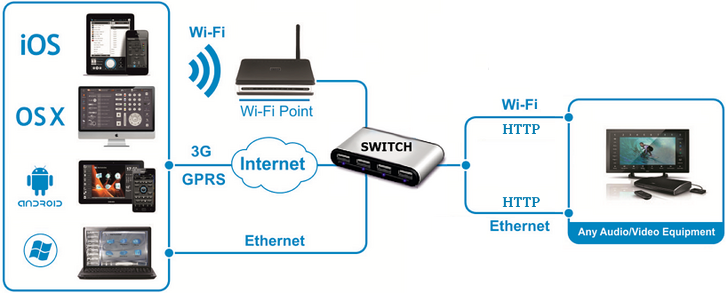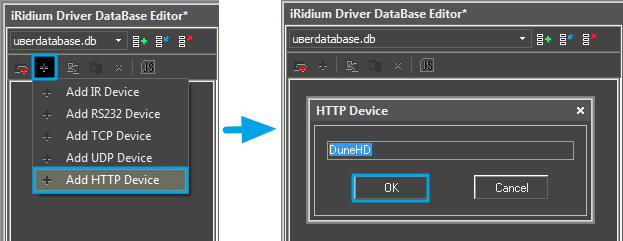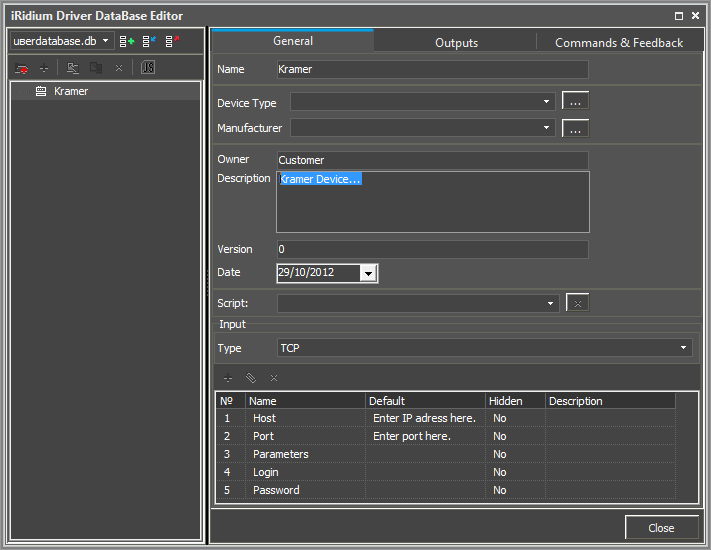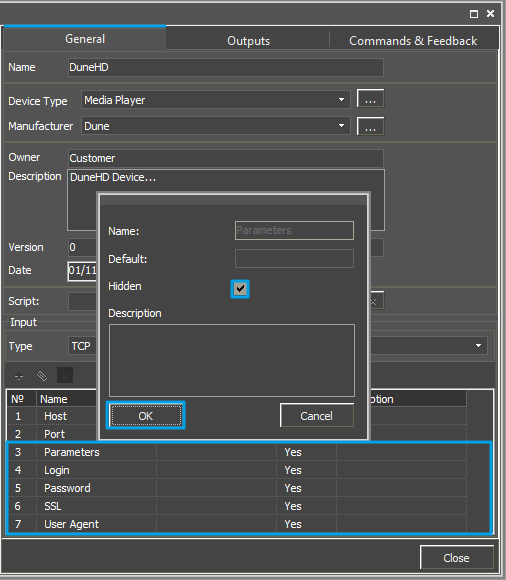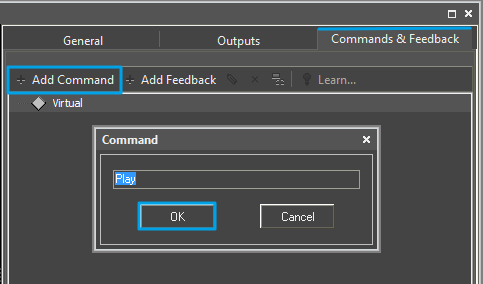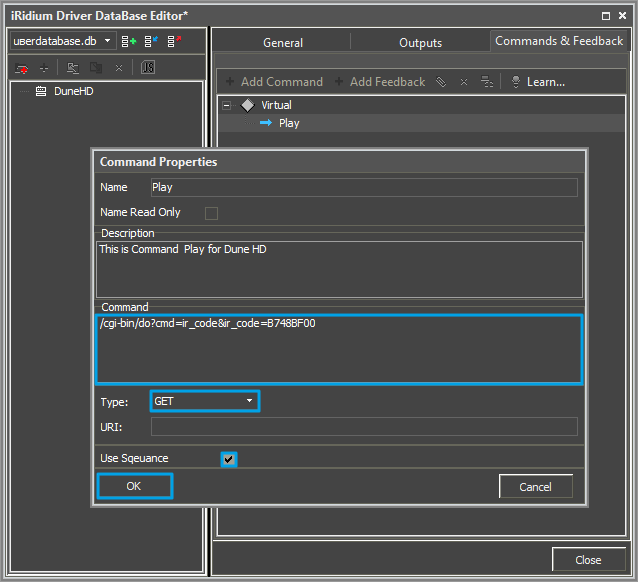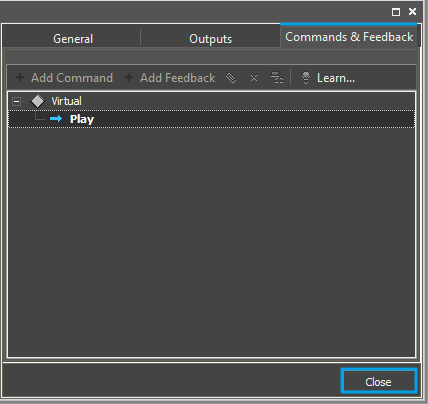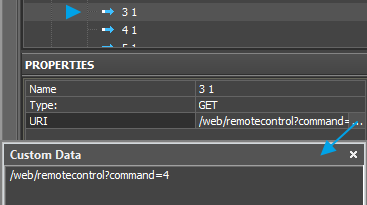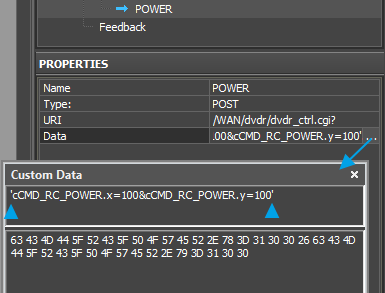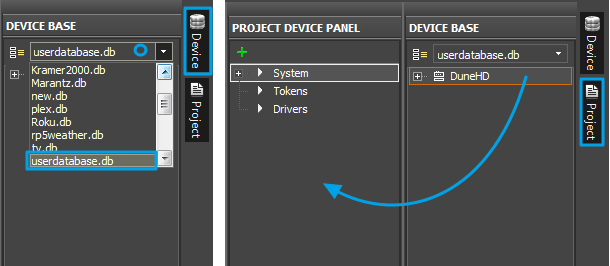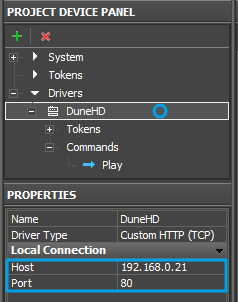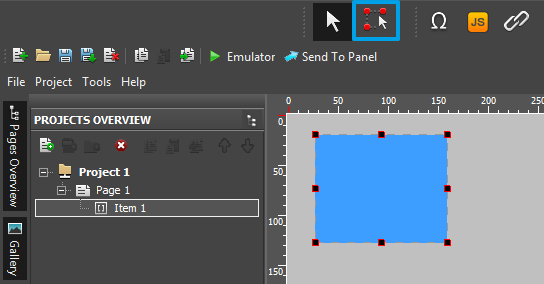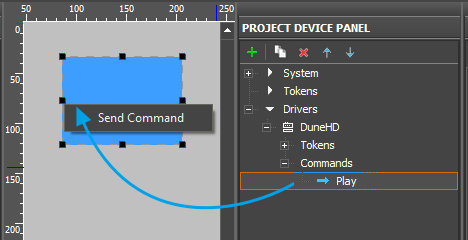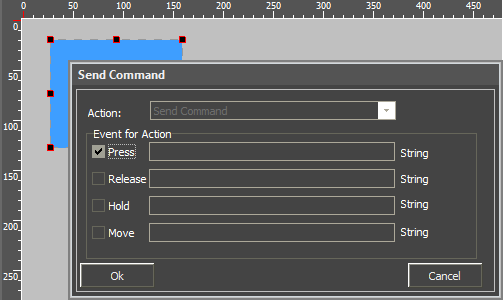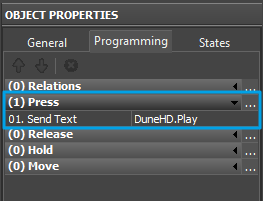AV & Custom Systems: Control via HTTP
<< back (AV & Custom Systems: Working with Equipment via HTTP)
This article presents control of AV equipment or other systems via HTTP through the example of the DuneHD device.
Contents
Principles of Controlling Equipment via HTTP
To control Smart Home systems via HTTP commands (Ethernet or Wi-Fi) iRidium uses the freely customizable "AV & Custom Systems" (HTTP) which enables iRidium to send commands via HTTP (the commands are sent in the GET and POST formats). Thus the scheme of communication between an iRidium control panel and controlled equipment looks as follows:
Commands can be sent to HTTP devices in the ASCII format. When sending commands use special iRidium syntax to define the data format.
Adding HTTP Commands to iRidium Data Base
To store HTTP controlled devices with commands it is required to create their data base in iRidium GUI Editor. It will enable you to use the devices in any iRidium project.
DB Editor is used for adding devices controlled via TCP and their commands to iRidium base. New devices can be added only to custom data bases as standard bases contain ready preconfigured modules of devices which cannot be edited (you can only take modules from the ready bases).
Creating New Files of iRidium Data Base
Use your own data bases (created manually) for storing your devices not standard data bases which can be updated with releases of new versions of iRidium GUI Editor. The names of the base file and folder for storing are indicated when creating the file.
Creating New HTTP Devices
Tools for creating new devices in iRidium data base are available in the right-click menu. The type of the created device - HTTP (HTTP Device) – defines its characteristics. For HTTP devices you can indicate information about the manufacturer, type of the controlled equipment, comments and commands.
Setting Up HTTP Devices
Creation of description for new devices is not compulsory but it can help with their further identification
- Device Type – a type of the controlled device (TV, DVD, Blu Ray, ...)
- Manufacturer – the name of the device manufacturer
- Description – description of the device, it can include hyper links
- Date – the date of creating the driver
HTTP devices have the following properties for connection:
- Host – an IP-address of the controlled Kramer device in your network.
- Port – a port the device works through.
Optional properties:
- Parameters – additional properties for connection
- Login – a login for connection
- Password - a password for connection
- SSL - a cryptographic protocol which enables safe connection between the device and the server.
- User Agent – a part of the HTTP request usually including such information as application name and version, PC OS and language.
These optional properties are used seldom and if you are not going to use them it is recommended to hide them: click two times on each property to open the window for settings and select Hidden.
To add the command in the list of the created device go to the Commands & Feedback tab and use tools of the Editor base:
The command is created empty by default. The instruction the command should send is indicated in the Command Properties windows. Click two times on the created command to open the Command Properties window.
- Write the instruction for the command in the Command field of the opened window. In our case for the Play command there is the '/cgi-bin/do?cmd=ir_code&ir_code=B748BF00' instruction, where:
- /cgi-bin/do?cmd=ir_code&ir_code – reference to the device
- B748BF00 - NEC command code (the command is sent in the ASCII format).
At that the command can be checked through the browser window, as a GET-request it looks as follows:
http://192.168.0.100/cgi-bin/do?cmd=B748BF00
Nec codes can be found here
- Select the GET method in the Type field.
- GET – a request in one string
- POST – sending a block of data
- Mark the Name Read Only field if you do not want to change the command name in the future (it is used when the driver works with scripts which refer to the command identifying it by its name).
- In the Descriptions field indicate the command description.
- Now you can close the DB Editor window.
Syntax of HTTP Commands
Commands for sending via the HTTP protocol cannot be added to DB Editor without checking them for compliance with the syntax accepted in iRidium. It allows you to identify the command data format and form the command correctly so it could be read by the controlled equipment.
The syntax of data sending via HTTP (GET and POST) defines the rules for sending data in the ASCII format.
Sending GET Requests
When working with the AV & Custom Systems driver via HTTP GET requests are formed with the following view:
httр://<ip address>:<port>/<command_body>
To form a GET request in iRidium indicate the body of the GET request with the first slash in the Data window of the data sending channel. For example:
httр://192.168.0.100:81/command
- Red color indicates the part of the GET request which should be written in the Data window.
- IP-address and port of connection to the device controlled via the web-interface are indicated in the driver properties.
The string in the Data window looks as follows:
/command
Sending POST Requests
A POST request for sending via the AV & Custom Systems (НТТР) driver should be divided in 2 parts: URI (head) и Data (body).
The head of the request (URI) is the part of the hyper link which defines the directory the request is addressed for. It starts with the back slash and can contain any kind of data. The head is in the upper part of the POST request.
Further there is system information which should not be duplicated in iRidium.
The request body (Data) is separated from it. The separation is made by double combination of two symbols – the symbol of the string end and the symbol of carriage shift: 0D,0A,0D,0A. In the editor it will look as an empty string between request strings. There can be any data in the request head and body. The request body should be written in 'single quotes' when you add it in the Data field!
Example 1:
POST /YamahaRemoteControl/ctrl HTTP/1.1
Accept: */*
Accept-Language: ru
Referer: http://192.168.10.102/
Content-Type: text/xml; charset=UTF-8
Accept-Encoding: gzip, deflate
User-Agent: Mozilla/4.0 (compatible; MSIE 8.0; Windows NT 6.1; WOW64; Trident/4.0; SLCC2; .NET
CLR 2.0.50727; .NET CLR 3.5.30729; .NET CLR 3.0.30729; Media Center PC 6.0; BRI/2)
Host: 192.168.10.100
Content-Length: 105
Connection: Keep-Alive
Cache-Control: no-cache
Cookie: mstnc=1
<YAMAHA_AV cmd="PUT"><System><Power_Control><Power>Standby</Power></Power_Control></System></YAMAHA_AV>
Example 2:
POST /WAN/dvdr/dvdr_ctrl.cgi? HTTP/1.1
User-Agent: MEI-LAN-REMOTE-CALL
Host: 192.168.1.105
Content-Length: 39
cCMD_RC_POWER.x=100&cCMD_RC_POWER.y=100
- Green color indicates the part of the POST request which should be written in the URI window .
- Red color indicates the part of the POST request which should be written in the Data window in single quotes.
Adding HTTP Devices to iRidium Projects
- Create a new project. New projects can be created with the help of the button on Tool Box or through the menu File > New Project.
You can find more information about project creating in the section Creating the Graphic Part of iRidium Projects
Select the userdatabase.db data base in the Device Base panel and add the DuneHD device you have in Project Device Panel of your project using the Drag&Drop method.
To connect iRidium to DuneHD, indicate the local IP-address in general settings of the device in the PROPERTIES window of the Project Device Panel:
- Host – an IP-address of the controlled DuneHD device.
- Port – a port the device works through.
To work with the DuneHD device via the Internet indicate the public IP-address of the router the converter is connected to. Set up the Port Forwarding Service for the router which enables possibility of referring to the local address of the controlled converter from the Internet (remote control).
You can learn the external (public) IP-address of your router with the help of external resources, for example [1]
Select the Draw Item tool and create a new item.
Open commands of the DuneHD device and drag the Play command on the item. Select send command in the appeared window.
In the Send Command dialog window select the type of the event which will activate command sending to the device.
- Press – pressing on the item
- Release – releasing the item
- Hold – holding the item
- Move – moving on the item (it is mainly used for the Level item type)
The Press event is indicated by default as the most commonly used.
The commands added on the item can be seen in the Programming tab of the Object Properties panel.
Launch Emulator to check how the command works.
<< back (AV & Custom Systems: Working with Equipment via HTTP)
